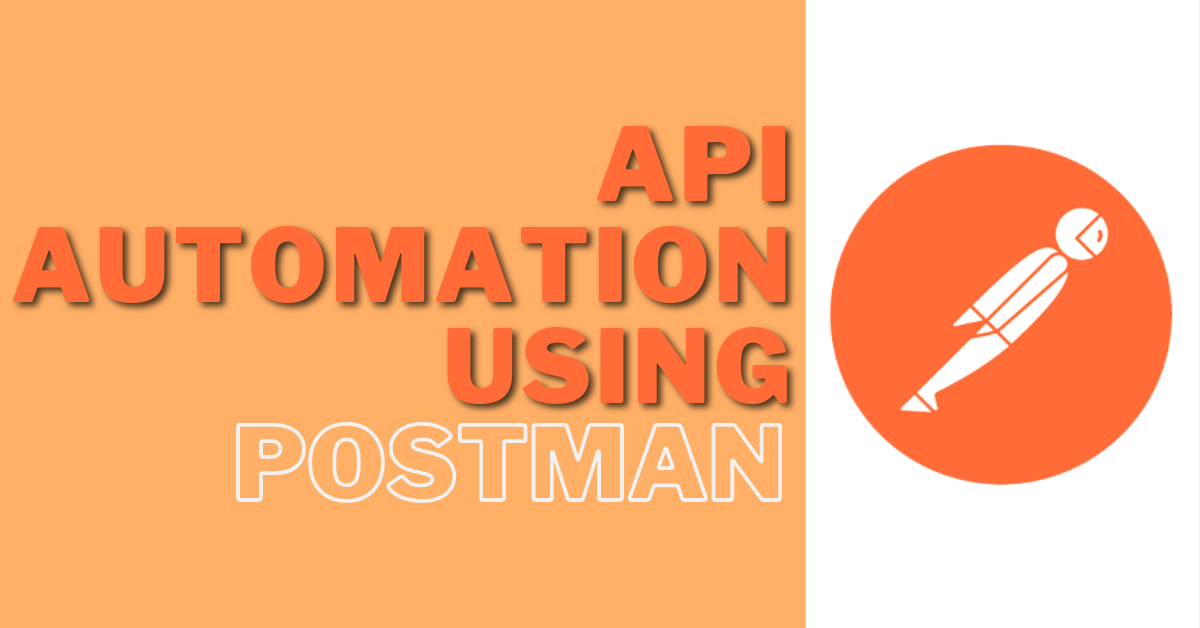
Introduction:
Test-Driven Development (TDD) is a critical practice in software engineering that focuses on improving software quality and reducing errors. This article delves into TDD and its implementation in the context of Flutter development. We’ll explore the stages of TDD, its advantages and how it contributes to creating reliable and robust software solutions.
STLS:
Testing is the process of discovering as many defects as possible, and one of the processes that can be applied to achieve testing is the STLC, which stands for Software Testing Life Cycle. This process consists of six stages as follows:
1. Requirements Analysis: In this stage, the testing team works on understanding the project requirements. This stage is crucial to avoid any misunderstandings of the requirements, which could lead to invalid tests.
2. Test Planning: In this stage, a test plan is created, and several factors are determined, including:
a. Defining the scope of testing, identifying the functionalities and features that should be tested and those that should not be tested.
b. Identifying the attributes that the project should achieve and need to be tested, such as functionality, security, usability, etc.
c. Documenting all the outputs produced during the testing process, including:
- i. Test Scenarios: These include the possible scenarios that need to be executed to test the software, describing how the tests should be executed and what needs to be tested.
- ii. Test Cases: These include the detailed steps required to execute each test scenario, describing how the test should be executed and how to evaluate the results.
- iii. Test Data: These include specific data that needs to be used in the tests, including inputs, expected outputs, and any other relevant data.
3. Test Case Development: In this stage, the test cases that were defined in the test planning stage are written.
4. Test Environment Setup: The test environment refers to the software and hardware through which the application is tested. In this stage, the necessary elements required for testing are verified and set up.
5. Test Execution: In this stage, the tests are executed, and the results are monitored. If any errors occur, communication with the development team takes place to resolve the issues.
6. Test Cycle Closure: This is the final stage in the testing process, where the results are analyzed and evaluated.

TDD:
It is an abbreviation for Test Driven Development (TDD), which means writing tests before writing the actual (production) code.
Through this approach, we replace between stages of developing a software product. Here, we first write the test code and then write the actual (production) code.
TDD Stages:
TDD is generally implemented through the following steps:
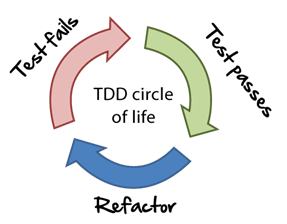
- Write a small, specific test for a certain function.
- Run the test and verify its failure (red).
- Write the necessary code to make the test pass (transition from red to green).
- Run the test and verify its success (green).
- Refactor the code (remove duplication, improve reusability, etc.).
- Repeat the above process for other cases and functions.
TDD Example:
Let’s consider a function whose task is to perform a mathematical operation, specifically addition. In the traditional approach, we would write the addition function first, then define the test cases, and finally apply the test cases to the function and compare the results.
In TDD, we would start by writing the test cases for the addition function. For example, when given two numbers, x1 and x2, we expect the result to be x3. Then, we write the code specific to this test case and execute the test. At this point, the result would be a failure (red) because the actual code logic has not been written yet.
Next, we move to writing the actual code for the addition function. Once we finish writing it, we execute the test code we previously wrote. Here, we have two possibilities: either the test passes (green), and then we move on to another test case, or it fails. In the case of failure, we modify the actual code and retest it until it passes (becomes green).
TDD Rules:
- You are not allowed to write any production code unless it is to make a failing unit test pass.
- You are not allowed to write any more of a unit test than is sufficient to fail; and compilation failures are failures.
- You are not allowed to write any more production code than is sufficient to pass the one failing unit test.
TDD Benefits:
- TDD helps to avoid errors in the early stages of development because we create tests for each function from the beginning. These tests are repeatedly executed to verify the success of the function and ensure the absence of errors.
- TDD helps improve software quality by creating precise and specific tests for each function from the start. As a result, the code is written in a way that aligns with these tests and ensures their achievement. When the necessary code is written to pass these tests and it is continuously improved and cleaned throughout the development process, the resulting code is clean and optimized, without any redundant or unnecessary parts. It also improves code flexibility and maintainability in the future, thereby enhancing software quality and reducing issues and errors in the long run.
- TDD helps in developing code logic. By writing tests for each function from the beginning and repeatedly running them, developers can use these tests to guide the code logic while adding more functionality. Starting with simpler functions first allows developers to break down the problem into smaller, more manageable parts. This aids in better and more efficient problem-solving.
TDD using Flutter:
We can write the test cases we want to achieve before writing the actual code (production code) using the tests provided by Flutter.
We know that there are three types of tests in Flutter: Unit Test, Widget Test, and Integration Test. In this article, we will focus on Unit Testing.
Unit test in flutter:
Unit testing is a type of software testing that is applied to the smallest unit of code, (such as a function – method ..etc).
Unit testing goes through three stages:
Arrange: In this stage, everything necessary for executing the test is prepared. This involves setting up the required conditions for the test to be executed successfully, initializing any values, variables, or inputs needed for the test.
Act: The unit being tested is executed based on the prepared conditions from the previous stage. The result of executing the unit is stored in a specified variable for later use in the third stage.
Assert: In this stage, the result of executing the unit is verified and compared to the expected result that was prepared in the first stage. This stage involves using assert functions to check the correctness of the result and to verify the occurrence of expected events, such as calling a specific function and ensuring that the tested unit behaves as expected.
Example:
There is a class that contains a function called “increment.” The goal is for this function to increase the value of “value” by one each time it is called.
We will follow TDD (Test-Driven Development) in the development process. We will create two files: the first one is “counter.dart,” and the second one is the test file, “counter_test.dart
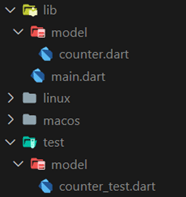
The “counter” class will contain the function that we want to apply TDD to. It’s important to note that we should not write any logic inside this function before writing its corresponding unit test.
As in the following figure:
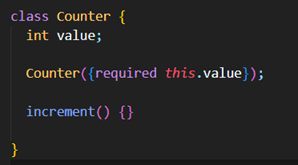
We are writing the increment unit test
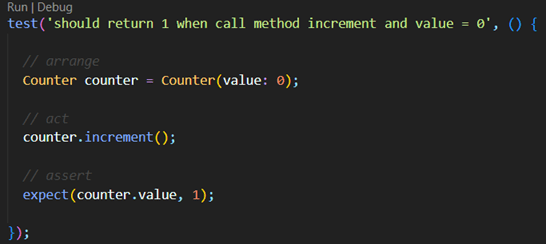
The result will be failure (RED) because we haven’t written the logic for the increment yet.

Now we go to the actual (production) code and write the increment logic.
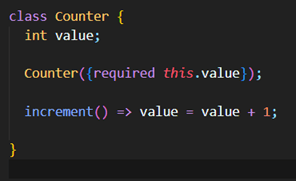
After writing the logic for the “increment” function, we need to rerun the unit test to ensure that the function behaves as expected.
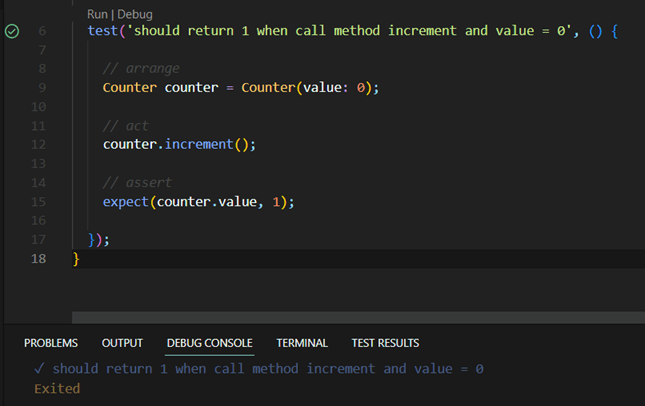
We find that the test passed.
Conclusion:
After working on software development for several years, it has become evident that Test-Driven Development (TDD) has become essential for building high-quality software and reducing errors in code. TDD helps increase the effectiveness of the development process and improve the quality of the final product.
Therefore, using TDD is considered a good investment in enhancing the quality and productivity of the development process.


